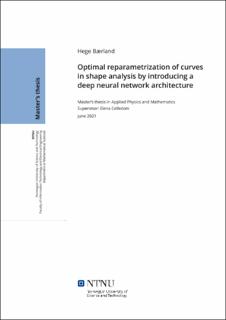Optimal reparametrization of curves in shape analysis by introducing a deep neural network architecture
Master thesis
Permanent lenke
https://hdl.handle.net/11250/2824270Utgivelsesdato
2021Metadata
Vis full innførselSamlinger
Sammendrag
Former er typisk beskrecet som det som er igjen av et objekt uten å ta hensyn til plassering, rotasjon og størrelse.
En stor del av formanalyse består av å definere likheter og forskjeller mellom formene for å utføre ulike applikasjoner, som for eksempel interpolasjon. En avstandfunksjon er så definert, og i denne avhandlingen vil en elastisk måleenhet fra [37] bli brukt. Siden denne måleenheten endrer seg for kurver med ulik parametrisering, må vi minimere distansen over alle reparametriseringene når to kurver blir sammenlignet. Dette er et uendelig dimensjonalt optimeringsproblem og hovedfokuset i denne avhandlingen, hvor vi diskretiserer slik at i praksis så ender vi opp med å optimere bare over et endelig antall parametere.
Flere iterative teknikker blir utprøvd for å løse optimeringsproblemet, som gradient descent og Adam. I tillegg blir et nevralt nettverk introdusert for å gjøre optimiseringen mer effektiv, hvor parametriseringsfunksjonen blir brukt som aktivasjonsfunksjonen i hvert lag som genererer den nye parametriseringen og dens deriverte. Implementasjonen algoritmene diskutert i avhandlingen har blitt utført ved bruk av Python og tensorbiblioteket for dyp læring, PyTorch. Shapes are typically described to be what is left of a object after filtering out translation, rotation and change of size.
A big part of shape analysis consists of defining similarity and differences between shapes in order to perform different applications, such as interpolation. A distance function is then defined, and in this thesis we will use a elastic metric from [37]. Since this metric changes for curves with different parametrization, when comparing two shapes we need to optimize the distance over all reparametrizations. This is an infinite dimensional optimization problem and the main focus of this thesis, where we discretize so that in practice we end up optimizing only over a finite number of parameters.
Several iterative techniques will be tested to solve the optimization problem, such as gradient descent and Adam. Additionally, a deep neural network architecture is introduced to make the optimization more efficient, where the parametrization function is described as a single or multiple composition of an affine transformation and an activation function with a skip connection. The implementation of the discussed algorithms has been performed using Python and the tensor library for deep learning PyTorch.
